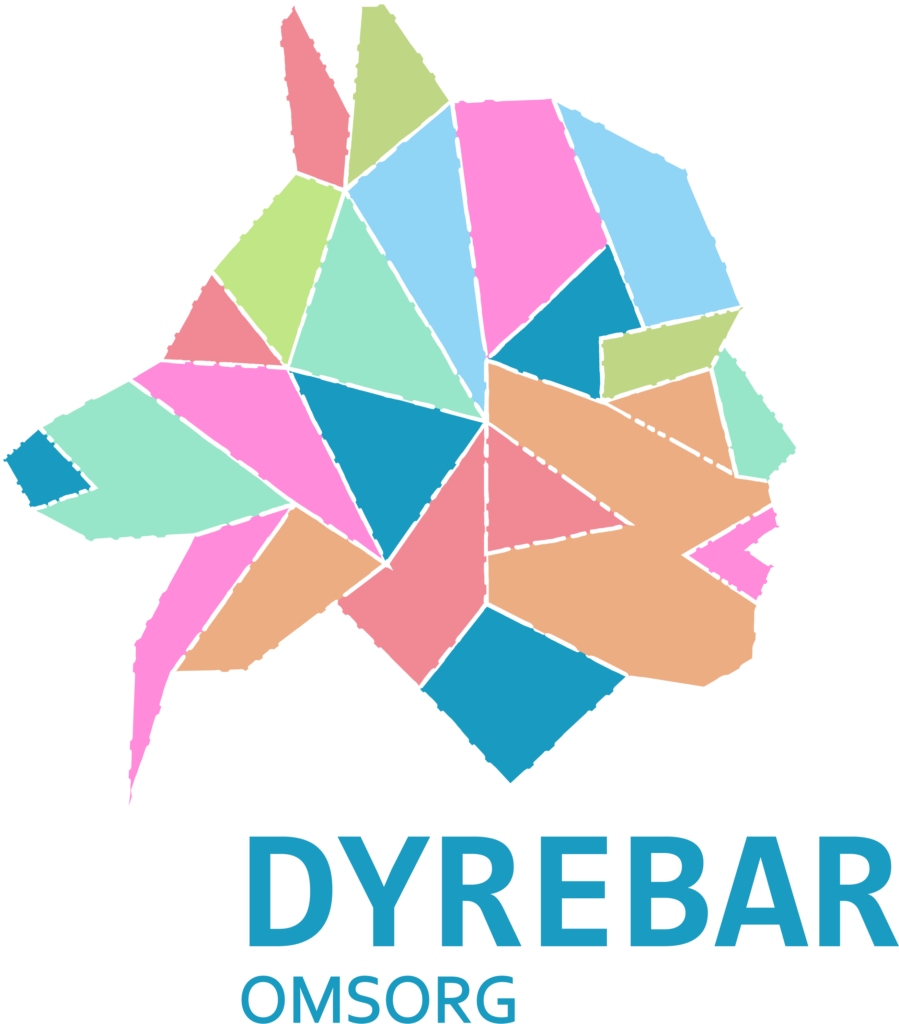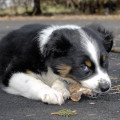Basics of the Human-Dog Relationship
Prepared by Line Sandstedt and Mari-Louise Asp 
History
The human-dog relationship goes back a long time. The dog was the first domestic animal, and the dog’s´ ancestor, the wolf, was probably domesticated by hunters and gatherers, long before they settled down as farmers (Savolainen in Jensen 2013). Humans, through selective breeding, have changed wolves into dogs; a “man’s best friend”. When we domesticate a species such as dogs, it leads to a retention of juvenile-behaviours, thus a dog will show more juvenile-behaviour in adulthood than a wolf (Coppinger & Shneider in Serpel 1995). Having studied free-ranging, unowned dogs, when looking at the organization of social behaviour, researchers found that a lot of different breeds have problems in maintaining stabile groups with other dogs. They cannot cooperate to hunt large prey; therefore, in one way or another, they rely on humans for food. Dogs brought up with humans form a closer relationship with them than wolves brought up with humans. Dogs both read human signals and communicate very well with humans. Dogs have acquired a skill for communication “with humans in a unique way” (Hare et al, 2002 in Jensen). Throughout time we can see a huge difference in the way that dogs have been kept, along with a large cultural diversity. In earlier times, dogs were often kept because of their ability to work as guard-dogs, herding-dogs and police-/military-dogs. These dogs often lived outside in kennels. Nowadays dogs are more frequently kept with the family as family-members, and are kept for such reasons as company and friendship. From being dogs´ masters or owners, today many people regard humans as benevolent leaders and guides for their dogs (Pregowski, 2015).
Attachment
It has been found that dogs can relate to humans on the basis of attachment and that they also benefit from this. So far, the data indicate that the relationship between dogs and their owners is associated with the same neurobiological mechanisms that underlie relationships between humans (Julius et al 2012). Attachment refers to a particular type of bond that develops between an infant and its primary caregiver, usually the mother (Bowlby, 1958). If the infant has a secure and healthy attachment to its caregiver, it will feel safe to explore its surroundings. If it gets scared, it will return to the safe base (Ainsworth, 1989 and Waters and Cummings, 2000). Initially, scientists believed that attachment was only related to food. However, Harlow demonstrated that attachment develops as a result of the mother providing “tactile comfort”, indicating that infants have an innate (biological) need to touch and cling to something for emotional support. Palmer and Custanse (2007) found that dogs were exploring their environment more in the presence of their owner than in the presence of a stranger. Dogs also increased the amount of independent play when their owner was present.
Relation
In this respect, it is important that we change our way of looking at our relationships with our dogs. Recent research shows that dogs are not wolves. Hence, our relationships with dogs do not need to be based on the rules applied in a wolf society, such as pack order system with a strong hierarchy. On the other hand, looking at dogs as children is not necessarily the right thing to do, either. Both types of models seem to fail to recognize the exceptionally high variability in the dog-human relationship (Miklosi, 2015). Miklosi writes in his book Dog behaviour, evolution and cognition (2015) that it will be better to develop new models, based on different approaches. One possibility could be to use the concept of friendship. That will include the possibility to be equal collaborative partners by playing different roles in the social interaction. Resent research on pack structure shows that long-term relationships are preferred and are an important aspect of this friendship. Good relations give security, experience and increased access to food. It is also of essence that pack members can reconcile after a conflict (Svartberg 2010).
Relation – structure

In his book Bra Relation (2010), Svartberg developed a model for human-dog relationships. He talks about three specific roles that we have to consider regarding our relationship to dogs. He emphasises the importance of trust, cooperation and the ability to decide (or make a decision). If you have friendship, trust and security, the dog will feel safe with you, and the desire to feel safe is very important to all living creatures. Through cooperation, you teach your dog that you are positive and that you work with your dog’s positive emotions. The dog also needs to know that it has to adjust to you, even if the dog does not want to do so (decision-making).
This is a flexible and dynamic model (Svartberg, 2010). If you lack something in the trust area, you will need to work on that element. And after working on it for some time, you may find that the dog does whatever it likes and you then have to work within the red area. Some people like the green circle to be very large and the red one to be very small. Then again, in other relationships the red circle can be bigger and the green one relatively smaller. There will be different relationships depending on the handler and the dog, and also depending on the situation.
Trust
If the dog trusts you and relies on you, it will be easy for it to relax and to overcome scary situations. You need to be very clear in your communication with your dog. When life is difficult for the dog, the situation can be eased if the owner feels and acts calm and relaxed, as the dog will then sense the owner’s state of mind. In every dogs life there will be challenging situations which could make them feel threatened. If the dog and the handler have a good relationship, and the dog feels safe and secure, the dog can cope with the situation much better.
The need for trust and safety is very important for all living creatures. Maslow suggested that people possess a set of motivation systems in which the basic level has to be fulfilled before you can reach the next level: the Maslow hierarchy of needs. In this model the physiological needs related to safety have to be fulfilled first. Therefore, safety is the basis of this human-dog relationship model (Svartberg, 2010). The dog has to feel friendship and security from their owner. If the dog likes to be near you, it will be easy for it to relax when you are relaxing. If it gets scared, it will cope better if you have a good relationship. The dog needs to know that it can trust you in all situations. This puts a huge responsibility on the owner and it is important that the owner takes this responsibility seriously and protects the dog from danger and potentially dangerous situations. The owner has to be calm and relaxed; otherwise, the dog will not be able to calm down or feel safe. The owners´ communication should be open to dogs´ feelings and state of mind. When hands and body are used in a calm and relaxing way, the dog will find peace and security in contact with humans. Touching the dog in a nice and positive manner will help release the hormone oxytocin, which is associated with a positive emotional state (Mitsuii et al., 2011).
An owner must take care of the dogs´ basic needs, such as food, water, warmth, sleep etc. (ref. Maslow). However, Svartberg (2010) also believes that you must show the dog you care about it and that you enjoy spending time together. Try to find some peace and closeness that both the dog and you can appreciate. It is nice if you can relax and sleep together. Yet, you must also teach the dog to feel safe when alone without you as well.
Work on being calm and relaxed. When we are together with our dog, we often do things: we go for a walk, we engage in training or play. Sometimes, the only place where we are calm and relaxed is inside our house (and even here we could actively play with the dog). The relationship between dog and owner will improve if they spend more time just being together, not doing anything outside of the house as well. The handler can, for example, go to the city/market, and sit down with the dog between his/her legs. The reason why it should sit between it´s handlers´ legs is that the dog will feel safe siting like this. The dog has the handler behind and the world in front, and the handler can secure the dog in this position . No humans or animals/dogs should be allowed to greet the dog while it is sitting in this position. The handler has to convince the dog that this is the safest place for him/her to be. As the handler, make sure that you look in the same direction as the dog. Do not look at the dog, eye contact will make the dog’s expectations rise. You can use this when you want to be active with your dog.
Trust is not something anyone can buy or get, trust is something one has to earn from the dog. Presence is very important for building a good relationship with the dog; it is essential that you and the dog spend time together just observing the strange world (Bodfäldt, 2010).
The handler has to be aware in all situations, think ahead and take responsibility for the dogs´ experiences. In situations where the dog gets scared, panics or even shows aggressive behaviour, the handler must stay with the dog until it is relaxed and calm again. It is common to get frustrated, angry and stressed if the dog is acting up, but it is not a clever strategy to respond to negative behaviour with more negativity. The result could be that the dog gets even more frustrated or scared or it may think that the handler is also afraid (Svartberg, 2010).
Cooperation
The relationship with your dog will be much easier if the dog perceives you as a fun and attractive person. If you give the dog interesting and positive cues, the dog will follow them and will develop a positive attitude towards you. Instead of only walking the dog, you can do a lot of interesting things as well. When the dog runs in front of you, you can take a toy or a treat (something that the dog loves to play with or likes to eat) and hide it in a tree. Then you can start to walk around the tree looking up at the item you put there. After a little while the dog will come and see what you are doing, then you can point at the toy/food and say something about it to the dog. You can then take it down and give it to the dog. In this way the dog will look at you as a great “hunter”, you find things that the dog cannot find. Another thing you can do, for example, is to put/hide treats or toys (hide it well) around a tree or a pole and do the same thing the dog does (instead of looking up, you can act like you are sniffing the ground). Your imagination is your only limit in showing your dog how clever you are! Make the dog follow you: instead of calling the dog’s name when it is off the leash, you can go in the other direction without saying anything to the dog. When the dog comes to you, you can give him/her a reward. The reward can be food, a toy or a lot of praise from you. The main thing is that the dog loves the reward, so that it chooses it rather than all the other things that it could find elsewhere. Having good rewards that the dog really loves is important for the relationship. Take some time to find the right reward for your dog. The dog that will play with both an object and its owner is easier to train than a dog that is very picky with their rewards. Playing is important for many mammals. Researchers believe that playing can facilitate the establishment of behavioural routines, strengthen individual relations and provide physical and mental exercise (Bekoff and Byers 1981). Playing will provide several positive experiences in the relationship between the handler and dog. Dogs that want to play with humans are easier to train than dogs that do not like to play (Asp et al, 2015). Dogs are less competitive and more interactive in play with humans than when playing with other dogs, they give up possession of toys more easily in play with humans, and offer the object more frequently to their human play partners (Rooney et al, 2000).
Co-operation is a factor that gives both the dog and the owner great value. It is really about finding positive resources in both the handler and the dog. Then the dog will be engaged, happy and playful. One of the handler’s tasks is to find rewards that help the dog develop these feelings (Svartberg, 2010).
You make decisions
In some situations, especially in everyday life situations, we have to be able to stop the dog and redirect it to something else. It is of immense importance that the dog listens to you, even if the dog really wants do to something else (e.g. chase a cat). Dogs seem to be open to human control and rules. If the handler is clever and shows the dog that he/she knows best and is in charge of the resources, it is quite easy to get the dog to respect the handler’s will. Around humans, dogs are less liable to defend their resting space and food resources, they see toys as something to co-operate on, and they learn that humans will not be interested in being their potential sex partner. Of course, a dog can be aggressive towards their owner, this will often be in situations when the dog experiences pain, when the dog is afraid or when the dog has something it does not want to share. That should be looked upon as lack of confidence and not as if the dog wanted to take “charge” (Svartberg, 2010).
An important thing to remember is to make sure that you do not try to set boundaries for your dog when the dog is far away. If the dog jumps up on the table and takes your food, and you are 3 meters away, you cannot do anything. If you tell the dog that this is not allowed, and it eats the food anyway, you teach it that it does not have to listen to you. But if you are 1 meter away, and you can actually stop the dog with your body, then you can tell the dog that this is not allowed. If the dog runs to another dog, and you know that the probability for the dog to come when you are calling is zero, do not call. You just teach the dog not to listen to your commands. But if you have the dog on a long leash, and you have hold of the leash, you can call the dog. If the dog does not listen, you can stop it with the leash and call one more time. The dog learns that it has to listen to you and there is no way around your commands. It is important that we do not demand more of the dog than is reasonable, we cannot expect more than the dog can cope with. If we put the dog in situations it cannot cope with, the dog will lose its trust in us, and the good relationship we have established with our dog will crumble away.
Summary
A dog that is safe and content, that loves being with you and wants to listen to your cues, is very easy to have in everyday life and it will make both the dog and you happy J
References
Asp, H, E., Fikse, W. F., Nilsson, K., Strandberg, E. (2015). Breed differences in everyday behavior of dogs. Applied Animal Behavior Science 169 (2015) 66-77.
Bekoff, M. and Byers, J.A. (1981). A critical reanalysis of ontogeny of mammal social and locomotor play: An etological hornet´snest, in Behavior Development: The Bielefeld Interdisciplinary project, ed. K. Immelmann, G.W. Barlow, L. Petronovich and M. Main. Cambridge University Press, New York.
Bodfäldt, E. (2010). Follow me – a deal with your dog. Eva Bodfäldt Education. Stockholm, Sweden.
Bowlby,J. (1958). The nature of the cild´s tie to his mother. International Journal of Psycho-Analysis. 1958, 39, 350 – 373
Jensen, P. (2013). The behavioural biology of dogs. CABI International. Wallingford, UK.
Julius, H., Beez, A., Kotrschal, K., Turner, D., Ulvnäs-Moberg, K. (2012). Attachment to Pets. Hogrefe. New York.
Miklosi, A. (2015). Dog behavior, evoultion, and cognition. 2nd edition, University Press, Oxford.
Mitsui, S., Yamamoto, M., Nagasawa, M., Mogi, K., Takefumi, K., Ohani, N., Ohta, M. (2011). Urinary oxytocin as a noninvasive biomarker of positive emotions in dogs. Hormones and Behavior. Volume 60, issue 3, 2011. 239 – 243.
Pregowski, M. (2015). Your Dog is Your Teacher – Contemporary Dog Training Beyond – Radical Behaviorism, society & animal (2015). 1 – 19.
Rooney, N. J., Bradshaw, J. W. S. and Robinson, I. H. (2000). A comparison of dog-dog and dog – human Behavior. Applied Animal Behaviour Science, 235 – 348
Serpel, J. (1995). The Domestic Dog: Its Evolution, Behaviour and Interactions with People. Cambridge University Press. London, UK.
Svartberg, K. (2010). Bra relasjon – om samspelet mellom hund og människa med TSB-modellen. Svartbergs Hundkunnskap, Stockholm.
Waters, E and Cummings, E. (2000). A secure base from witch to explore close relationship. Child development 71. 164 – 172.
https://www.dyrebaromsorg.no



